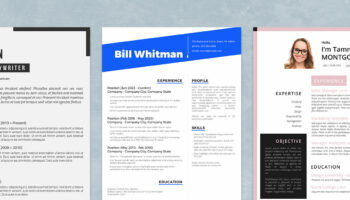You know the drill: a great resume should detail your “marketable” skills, work experience, and accomplishments. That’s not new information. What many people don’t know is that they can choose how that information is presented. Yes! You have the power to format your resume in a way that paints you in the best light. For many people, the functional resume format is the better choice.
What is a Functional Resume
If you are unfamiliar with the term “functional resume”, you may have heard of a skills resume. These are both the same thing.
A functional resume is meant to emphasize your core competencies and skills instead of your work history. Here are some of the most common elements that you will find in a functional resume:
- Your skill set in the form of a list or table.
- An abbreviated work history that ties directly to your skillset.
- Brief summary of your Education and professional training.
When to Use a Functional Resume
The functional resume is one of the popular resume formats, coming second to a “standard” reverse chronological resume.
But HRs will generally prefer a chronological resume over this option. So what situations call for a functional resume?
- You are going for a career change. A chronological resume may not be the best option when you are eyeing a new career path. This format will emphasize your lack of experience. A functional resume, on the contrary, lets you place the transferable skills and core competencies in the limelight.
- Your work history raises red flags. Hiring managers tend to get concerned when they see job hoppers aka people who held multiple jobs in a short time. The same is true if you’ve taken on a variety of roles or simply don’t have much experience at all. A functional resume helps conceal gaps in your employment and highlight your portfolio of skills, rather than linear career growth. Thus, it works well for temp workers and freelancers.
- Your key skills don’t come from your work experience. What if your most marketable skills are the result of a long-term hobby, volunteer work, internships, or academic research? Again, a functional resume could help you tell a better story.
How to Make a Functional Resume
If you’ve never written a functional resume before, you’ll need to set aside some of your perceptions about how a resume should be formatted. These tips will help you center your resume around your capabilities instead of your work history.
Organize Your Skill Set Into Logical Sections
First, prepare your list of skills. To make the thought process easier, organize them by groups such as:
Try to come up with a well-balanced ratio of hard and soft skills — 60% vs 40% is a good combo.
Next, take a functional resume template and place similar skills next to one another. Then, come up with a descriptive name for each group of skills. Imagine you are pursuing a job at a radio station. Here is an example of the skills groupings you might create:
- Announcing and Broadcasting: Interviewing, News Reading, On-air commentary, Play by Play, Presentation.
- Sales and Marketing: Advertiser outreach, Social media marketing, Account management, Street team.
- Technical: Audio production, board operation, remotes, AVAIR.
Make Your Employment History Work For You
It’s okay to use a functional resume if you don’t have an extensive employment history. However, you can’t skip the “employment section” altogether.

What you can do though is tweak this section to your advantage. Here are several quick tips:
- Group related short-term jobs together. For example: ‘Freelance Web Designer; Multiple Clients — January 2017 to Present’
- List jobs without giving much more detail, letting skills “do the talking”.
- Format jobs with a bulleted list of duties and accomplishments, illustrating the skills you have listed.
- Bolster a thin employment history by adding in academic research, volunteer work, and internships.
Sell Your Talents With a Professional Summary
Toss a standard career objective and use a professional summary instead. A good resume summary should emphasize two to three of your most marketable skills. Which ones? Get back to the original job post and read the “Candidate Requirements” section once again. See if you have a “match” in your skills list and bring that up in your summary.
Functional Resume Examples
So, what does a functional resume look like IRL? Here are several resume examples you can use as “scaffolding” when writing:
- Functional nanny resume example with extra writing tips.
- A resume that has been written for an inexperienced fresher in search of their first job.
- This example of a resume for a first-time job seeker shows to substitute the lack of experience with volunteer and internship entries.
Conclusion
If your work history isn’t extensive, or simply doesn’t exist, a functional resume may give you a better shot for landing the job. By drawing attention to your capabilities, you show employers that you still have something valuable to bring to the table.






